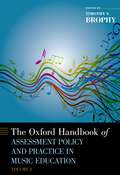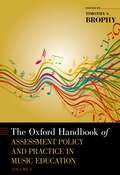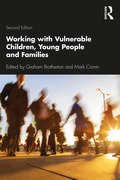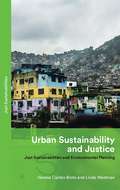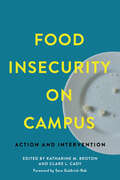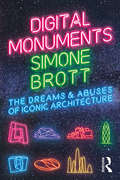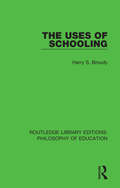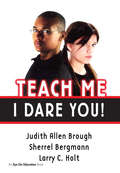- Table View
- List View
A Learning Community in the Primary Classroom
by Jere Brophy Janet Alleman Barbara KnightonThis richly detailed description and analysis of exemplary teaching in the primary grades looks at how a teacher establishes her classroom as a collaborative learning community, how she plans curriculum and instruction that features powerful ideas and applications to life outside of school, and how, working within this context, she motivates her students to learn with a sense of purpose and thoughtful self-regulation. The supporting analyses, which ground the teacher’s practice in principles from curriculum and instruction, educational psychology, and related sources of relevant theory and research, are designed to allow teacher-readers to develop coherent understanding and appreciation of the subtleties of her practice and how they can be applied to their own practice. Resulting from a lengthy collaboration among an educational psychologist, a social studies educator, and a classroom teacher, the aspects and principles of good teaching this book details are widely applicable across elementary schools, across the curriculum, and across the primary grade levels. To help readers understand the principles and adapt them to their particular teaching situations, an Appendix provides reflection questions and application activities.
Motivating Students to Learn
by Jere Brophy Kathryn R. WentzelWritten specifically for teachers in training, Motivating Students to Learn offers a wealth of research-based principles on student motivation for use in the classroom. Positioning the teacher as the decisive motivator, the book is grounded in the realities of contemporary schools, curriculum goals, and peer dynamics. Twelve rich chapters offer extrinsic and intrinsic approaches to guide daily practice, guidelines for adapting to group and individual differences, and ways to reach discouraged or disaffected students. This revised fifth edition features new instructional strategies, summaries of effective interventions, chapters on family/cultural diversity and teacher motivation, and more.
Motivating Students to Learn
by Jere Brophy Kathryn R. WentzelWritten specifically for teachers in training, Motivating Students to Learn offers a wealth of research-based principles on student motivation for use in the classroom. Positioning the teacher as the decisive motivator, the book is grounded in the realities of contemporary schools, curriculum goals, and peer dynamics. Twelve rich chapters offer extrinsic and intrinsic approaches to guide daily practice, guidelines for adapting to group and individual differences, and ways to reach discouraged or disaffected students. This revised fifth edition features new instructional strategies, summaries of effective interventions, chapters on family/cultural diversity and teacher motivation, and more.
The Oxford Handbook of Assessment Policy and Practice in Music Education, Volume 2 (Oxford Handbooks)
by Timothy BrophyIn the music classroom, instructors who hope to receive aid are required to provide data on their classroom programs. Due to the lack of reliable, valid large-scale assessments of student achievement in music, however, music educators in schools that accept funds face a considerable challenge in finding a way to measure student learning in their classrooms. From Australia to Taiwan to the Netherlands, music teachers experience similar struggles in the quest for a definitive assessment resource that can be used by both music educators and researchers. In this two-volume Handbook, contributors from across the globe come together to provide an authority on the assessment, measurement, and evaluation of student learning in music. The Handbook's first volume emphasizes international and theoretical perspectives on music education assessment in the major world regions. This volume also looks at technical aspects of measurement in music, and outlines situations where theoretical foundations can be applied to the development of tests in music. The Handbook's second volume offers a series of practical and US-focused approaches to music education assessment. Chapters address assessment in different types of US classrooms; how to assess specific skills or requirements; and how assessment can be used in tertiary and music teacher education classrooms. Together, both volumes of The Oxford Handbook of Assessment in Music Education pave the way forward for music educators and researchers in the field.
The Oxford Handbook of Assessment Policy and Practice in Music Education, Volume 1 (Oxford Handbooks)
by Timothy S. BrophyIn the music classroom, instructors who hope to receive aid are required to provide data on their classroom programs. Due to the lack of reliable, valid large-scale assessments of student achievement in music, however, music educators in schools that accept funds face a considerable challenge in finding a way to measure student learning in their classrooms. From Australia to Taiwan to the Netherlands, music teachers experience similar struggles in the quest for a definitive assessment resource that can be used by both music educators and researchers. In this two-volume Handbook, contributors from across the globe come together to provide an authority on the assessment, measurement, and evaluation of student learning in music. The Handbook's first volume emphasizes international and theoretical perspectives on music education assessment in the major world regions. This volume also looks at technical aspects of measurement in music, and outlines situations where theoretical foundations can be applied to the development of tests in music. The Handbook's second volume offers a series of practical and US-focused approaches to music education assessment. Chapters address assessment in different types of US classrooms; how to assess specific skills or requirements; and how assessment can be used in tertiary and music teacher education classrooms. Together, both volumes of The Oxford Handbook of Assessment in Music Education pave the way forward for music educators and researchers in the field.
Unerwartete Perspektiven der Schulpsychologie: ADHS, Kindeswohl, Wut, Mobbing, Prüfungsangst, Schulschwänzen
by Nicole Bröscher Charlotte Lindel Thora SchadowTäglich hören wir als Vertrauenspersonen verschiedene Seiten an. Und täglich staunen wir über die Stärke vieler Kinder, die Schicksal und schwierige Lebensumstände kreativ meistern. Heute ist es Max, gestern Chiara, morgen vielleicht Mohammed... Ihr Verhalten ist im individuellen Kontext immer sinnvoll- auch wenn es auffällt oder andere stört. Ein Buch aus der Praxis für die Praxis und die Autorinnen schöpfen dabei aus einer Fülle konkreter Fälle des Berufsalltags. Ein Dreiklang aus einfühlsamen Erzählungen, wissenschaftlicher Erklärung und praxisorientiertem Ratgeber: emotional, rational, handlungsorientiert.
Praxisguide Wissensmanagement: Qualifizieren in Gegenwart und Zukunft. Planung, Umsetzung und Controlling in Unternehmen (X.media.press)
by Michael Broßmann Wilfried MödingerPraxisorientierte Anleitung zur nutzbringenden Planung und Umsetzung von Wissensmanagement in Unternehmen. Sie beschreibt Wissensvermittlung mit Hilfe von Printmedien, Computer Based Training (CBT), Web Based Training (WBT), interaktivem Business TV, e-Training und Lernplattformen (Learning-Management-Systeme, LMS). So ermittelt sie den konkreten Beitrag dieser Verfahren in der Wertschöpfungskette von Unternehmen. Das Buch stellt den Return-on-Investment (ROI) des Wissensmanagements mit Hilfe einer dafür entwickelten Score Card dar. Plus: Perspektiven für die Zukunft durch Social Computing und Web 2.0-Anwendungen (Weblog, Wiki etc.).
Virginia Satir: Foundational Ideas
by Barbara Jo Brothers“Amid these [world] changes is the growing conviction that human beings must evolve a new consciousness that places a high value on being human, that leads toward cooperation, that enables positive conflict resolution, and that recognizes our spiritual foundations. Can we accept as a given that the self of the therapist is an essential factor in the therapeutic process? If this turns out to be true, it will alter our way of teaching therapists as well as treating patients.” (Virginia Satir in The Use of Self in Therapy, The Haworth Press, Inc., 1987Virginia Satir, an internationally renowned educator and master therapist and a pioneer in the field of family therapy, altered the way therapists are taught and patients are treated. This landmark volume focuses on the important contributions that she made to the therapy profession. Written and edited by therapists who trained and worked closely with her, Virginia Satir: Foundational Ideas reflects her most basic ideas about the healing quality of respect for all people and the emphasis on the personal aspects of treatment rather than the technical. It also addresses the necessity of emotional honesty between the therapist and the patient and illustrates these therapists’impact on therapy as it is practiced today.The legacy left by Dr. Satir includes her profound insight into the behavior of human beings and the guidelines for the application of universal principles in such a way as to enhance human growth and unite individuals. Her impact on therapists around the world is apparent upon reading this triumphant volume. Scholars and practitioners address some of the fundamental tenets of therapy as developed by Dr. Satir and explain how they have integrated these basic foundations into their own practices. The highlights of her professional contributions that are discussed in this exhaustive volume include: the basic patterns of communication that are common to all people and the relationship of communication and self-esteem the triad concept and strategies for teaching people to exist in this basic unit of humankind in a healthy way the parts party and how this process for integrating various aspects of a person can be used with couples as well the model for change process and the ways in which it can be used with individuals, couples, and the world family reconstruction and the value of acting out the past with the therapist as guideVirginia Satir: Foundational Ideas is a sharp, clear focus on the person and work of this great master. It is necessary reading for all professionals around the world who seek to better understand the therapy process and the keys to its success.
Virginia Satir: Foundational Ideas
by Barbara Jo Brothers“Amid these [world] changes is the growing conviction that human beings must evolve a new consciousness that places a high value on being human, that leads toward cooperation, that enables positive conflict resolution, and that recognizes our spiritual foundations. Can we accept as a given that the self of the therapist is an essential factor in the therapeutic process? If this turns out to be true, it will alter our way of teaching therapists as well as treating patients.” (Virginia Satir in The Use of Self in Therapy, The Haworth Press, Inc., 1987Virginia Satir, an internationally renowned educator and master therapist and a pioneer in the field of family therapy, altered the way therapists are taught and patients are treated. This landmark volume focuses on the important contributions that she made to the therapy profession. Written and edited by therapists who trained and worked closely with her, Virginia Satir: Foundational Ideas reflects her most basic ideas about the healing quality of respect for all people and the emphasis on the personal aspects of treatment rather than the technical. It also addresses the necessity of emotional honesty between the therapist and the patient and illustrates these therapists’impact on therapy as it is practiced today.The legacy left by Dr. Satir includes her profound insight into the behavior of human beings and the guidelines for the application of universal principles in such a way as to enhance human growth and unite individuals. Her impact on therapists around the world is apparent upon reading this triumphant volume. Scholars and practitioners address some of the fundamental tenets of therapy as developed by Dr. Satir and explain how they have integrated these basic foundations into their own practices. The highlights of her professional contributions that are discussed in this exhaustive volume include: the basic patterns of communication that are common to all people and the relationship of communication and self-esteem the triad concept and strategies for teaching people to exist in this basic unit of humankind in a healthy way the parts party and how this process for integrating various aspects of a person can be used with couples as well the model for change process and the ways in which it can be used with individuals, couples, and the world family reconstruction and the value of acting out the past with the therapist as guideVirginia Satir: Foundational Ideas is a sharp, clear focus on the person and work of this great master. It is necessary reading for all professionals around the world who seek to better understand the therapy process and the keys to its success.
Church and School: A Study of the Impact of Education on Religion
by Joan BrothersThis 1964 study makes an important contribution to the sociology of religion, as it enlarges the frontiers of the subject so as to include aspects of human conduct which ware both religious and social. In doing so, it challanges positivist conceptions of sociology and the social sciences more broadly. Joan Brothers's work explores the interaction between the organization, structure, and activities of a church and those of the wider society in which it is places.
Working with Vulnerable Children, Young People and Families
by Graham Brotherton Mark CroninThe potential for early intervention to prevent social problems later in life has become the focus of much debate in recent years and finds itself at the centre of contemporary social policy. The meaning of ‘vulnerability’ – one of the key concepts in this drive – is examined in this book, as well as the relationship between vulnerability and the individual, communities and society. This book introduces students to a broad debate around what constitutes vulnerability and related concepts such as risk and resilience, and examines how vulnerability has been conceptualised by policy makers with a clear focus on early intervention. Adopting a case study approach, it opens with chapters examining the concept of vulnerability from sociological, psychological and social policy perspectives before looking at examples around disability, homelessness, leaving care, victims of violence, sexual abuse, prison, the Internet and drug use. Supporting students in engaging with and evaluating the conceptualisation and application of vulnerability in professional practice, this book is suitable for anyone either preparing for or currently working within the children’s workforce, from social work and health care to education and youth work.
Working with Vulnerable Children, Young People and Families
by Graham Brotherton Mark CroninThe potential for early intervention to prevent social problems later in life has become the focus of much debate in recent years and finds itself at the centre of contemporary social policy. The meaning of ‘vulnerability’ – one of the key concepts in this drive – is examined in this book, as well as the relationship between vulnerability and the individual, communities and society. This book introduces students to a broad debate around what constitutes vulnerability and related concepts such as risk and resilience, and examines how vulnerability has been conceptualised by policy makers with a clear focus on early intervention. Adopting a case study approach, it opens with chapters examining the concept of vulnerability from sociological, psychological and social policy perspectives before looking at examples around disability, homelessness, leaving care, victims of violence, sexual abuse, prison, the Internet and drug use. Supporting students in engaging with and evaluating the conceptualisation and application of vulnerability in professional practice, this book is suitable for anyone either preparing for or currently working within the children’s workforce, from social work and health care to education and youth work.
Working with Vulnerable Children, Young People and Families
by Graham Brotherton Mark CroninThis fully revised and expanded edition considers the meaning of 'vulnerability' – a key concept in early intervention – and the relationship between vulnerability and the individual, communities and society. It includes new chapters on children’s voices, young people and vulnerability, and working with vulnerable parents. Introducing students to a broad debate around what constitutes vulnerability and related concepts such as risk and resilience, it examines how vulnerability has been conceptualised by policy makers with a clear focus on early intervention for preventing social problems later in life. It adopts a case study approach, using chapters examining the concept of vulnerability from sociological, psychological and social policy perspectives before looking at examples around leaving care, victims of violence, sexual abuse, and the Internet. Supporting students in engaging with and evaluating the conceptualisation and application of vulnerability in professional practice, this book is suitable for anyone either preparing for or currently working within the children’s workforce, from social work and health care to education and youth work.
Working with Vulnerable Children, Young People and Families
by Graham Brotherton Mark CroninThis fully revised and expanded edition considers the meaning of 'vulnerability' – a key concept in early intervention – and the relationship between vulnerability and the individual, communities and society. It includes new chapters on children’s voices, young people and vulnerability, and working with vulnerable parents. Introducing students to a broad debate around what constitutes vulnerability and related concepts such as risk and resilience, it examines how vulnerability has been conceptualised by policy makers with a clear focus on early intervention for preventing social problems later in life. It adopts a case study approach, using chapters examining the concept of vulnerability from sociological, psychological and social policy perspectives before looking at examples around leaving care, victims of violence, sexual abuse, and the Internet. Supporting students in engaging with and evaluating the conceptualisation and application of vulnerability in professional practice, this book is suitable for anyone either preparing for or currently working within the children’s workforce, from social work and health care to education and youth work.
Urban Sustainability and Justice: Just Sustainabilities and Environmental Planning (Just Sustainabilities)
by Vanesa Castán Broto Linda WestmanUrban Sustainability and Justice presents an innovative yet practical approach to incorporate equity and social justice into sustainable development in urban areas, in line with the commitments of the UN's Sustainable Development Goals and the New Urban Agenda. This work proposes a feminist reading of just sustainabilities' principles to reclaim sustainability as a progressive discourse which informs action on the ground. This work will help the committed activist (whether they are on the ground, working in a community, in a non-governmental organization (NGO), in a business, at a university, in any sphere in government) to connect their work to international efforts to deliver environmental justice in cities around the world.Drawing on a comparative, international analysis of sustainability initiatives in over 200 cities, Castán Broto and Westman find limited evidence of the implementation of just sustainabilities principles in practice, but they argue that there is considerable potential to develop a justice-oriented sustainability agenda. Highlighting current successes while also assessing prospects for the future, the authors show that just sustainabilities is not merely an aspirational discourse, but a frame of reference to support radical action on the ground.
Urban Sustainability and Justice: Just Sustainabilities and Environmental Planning (Just Sustainabilities)
by Vanesa Castán Broto Linda WestmanUrban Sustainability and Justice presents an innovative yet practical approach to incorporate equity and social justice into sustainable development in urban areas, in line with the commitments of the UN's Sustainable Development Goals and the New Urban Agenda. This work proposes a feminist reading of just sustainabilities' principles to reclaim sustainability as a progressive discourse which informs action on the ground. This work will help the committed activist (whether they are on the ground, working in a community, in a non-governmental organization (NGO), in a business, at a university, in any sphere in government) to connect their work to international efforts to deliver environmental justice in cities around the world.Drawing on a comparative, international analysis of sustainability initiatives in over 200 cities, Castán Broto and Westman find limited evidence of the implementation of just sustainabilities principles in practice, but they argue that there is considerable potential to develop a justice-oriented sustainability agenda. Highlighting current successes while also assessing prospects for the future, the authors show that just sustainabilities is not merely an aspirational discourse, but a frame of reference to support radical action on the ground.
Food Insecurity on Campus: Action and Intervention
by Katharine M. Broton Clare L. CadyAs the price of college continues to rise and the incomes of most Americans stagnate, too many college students are going hungry. According to researchers, approximately half of all undergraduates are food insecure. Food Insecurity on Campus—the first book to describe the problem—meets higher education's growing demand to tackle the pressing question "How can we end student hunger?" Essays by a diverse set of authors, each working to address food insecurity in higher education, describe unique approaches to the topic. They also offer insights into the most promising strategies to combat student hunger, including• utilizing research to raise awareness and enact change; • creating campus pantries, emergency aid programs, and meal voucher initiatives to meet immediate needs;• leveraging public benefits and nonprofit partnerships to provide additional resources;• changing higher education systems and college cultures to better serve students; and• drawing on student activism and administrative clout to influence federal, state, and local policies.Arguing that practice and policy are improved when informed by research, Food Insecurity on Campus combines the power of data with detailed storytelling to illustrate current conditions. A foreword by Sara Goldrick-Rab further contextualizes the problem. Offering concrete guidance to anyone seeking to understand and support college students experiencing food insecurity, the book encourages readers to draw from the lessons learned to create a comprehensive strategy to fight student hunger.Contributors: Talia Berday-Sacks, Denise Woods-Bevly, Katharine M. Broton, Clare L. Cady, Samuel Chu, Sarah Crawford, Cara Crowley, Rashida M. Crutchfield, James Dubick, Amy Ellen Duke-Benfield, Sara Goldrick-Rab, Jordan Herrera, Nicole Hindes, Russell Lowery-Hart, Jennifer J. Maguire, Michael Rosen, Sabrina Sanders, Rachel Sumekh
Food Insecurity on Campus: Action and Intervention
by Katharine M. Broton Clare L. Cady Sara Goldrick-RabAs the price of college continues to rise and the incomes of most Americans stagnate, too many college students are going hungry. According to researchers, approximately half of all undergraduates are food insecure. Food Insecurity on Campus—the first book to describe the problem—meets higher education's growing demand to tackle the pressing question "How can we end student hunger?" Essays by a diverse set of authors, each working to address food insecurity in higher education, describe unique approaches to the topic. They also offer insights into the most promising strategies to combat student hunger, including• utilizing research to raise awareness and enact change; • creating campus pantries, emergency aid programs, and meal voucher initiatives to meet immediate needs;• leveraging public benefits and nonprofit partnerships to provide additional resources;• changing higher education systems and college cultures to better serve students; and• drawing on student activism and administrative clout to influence federal, state, and local policies.Arguing that practice and policy are improved when informed by research, Food Insecurity on Campus combines the power of data with detailed storytelling to illustrate current conditions. A foreword by Sara Goldrick-Rab further contextualizes the problem. Offering concrete guidance to anyone seeking to understand and support college students experiencing food insecurity, the book encourages readers to draw from the lessons learned to create a comprehensive strategy to fight student hunger.Contributors: Talia Berday-Sacks, Denise Woods-Bevly, Katharine M. Broton, Clare L. Cady, Samuel Chu, Sarah Crawford, Cara Crowley, Rashida M. Crutchfield, James Dubick, Amy Ellen Duke-Benfield, Sara Goldrick-Rab, Jordan Herrera, Nicole Hindes, Russell Lowery-Hart, Jennifer J. Maguire, Michael Rosen, Sabrina Sanders, Rachel Sumekh
Digital Monuments: The Dreams and Abuses of Iconic Architecture
by Simone BrottDigital Monuments radically explodes "iconic architecture" of the new millennium and its hijacking of the public imagination via the digital image. Hallucinatory constructions such as Rem Koolhaas’s CCTV headquarters in Beijing, Frank Gehry’s Guggenheim Museum in Bilbao and Zaha Hadid’s Performing Arts Centre in Abu Dhabi are all introduced to the world by immortal digital imagery that floods the internet—yet comes to haunt the actualised buildings. Like holograms, these "digital monuments," which violently push physics and engineering to their limits, flicker eerily between the real and the unreal—invoking fantasies of omnipotence, immortality and utopian cities. But this experience of iconic architecture as a digital dream on the ground conceals from the urban spectator the social reality of the buildings and the rigidity of their ideology. In 18 micro-essays, Digital Monuments exposes the stereotypes of iconic architecture while depicting the savagery of the industry, from the Greek and Spanish crises triggered by financialised iconic development to mass labour-deaths on construction sites in the UAE.
Digital Monuments: The Dreams and Abuses of Iconic Architecture
by Simone BrottDigital Monuments radically explodes "iconic architecture" of the new millennium and its hijacking of the public imagination via the digital image. Hallucinatory constructions such as Rem Koolhaas’s CCTV headquarters in Beijing, Frank Gehry’s Guggenheim Museum in Bilbao and Zaha Hadid’s Performing Arts Centre in Abu Dhabi are all introduced to the world by immortal digital imagery that floods the internet—yet comes to haunt the actualised buildings. Like holograms, these "digital monuments," which violently push physics and engineering to their limits, flicker eerily between the real and the unreal—invoking fantasies of omnipotence, immortality and utopian cities. But this experience of iconic architecture as a digital dream on the ground conceals from the urban spectator the social reality of the buildings and the rigidity of their ideology. In 18 micro-essays, Digital Monuments exposes the stereotypes of iconic architecture while depicting the savagery of the industry, from the Greek and Spanish crises triggered by financialised iconic development to mass labour-deaths on construction sites in the UAE.
Higher Education System Reform: An International Comparison after Twenty Years of Bologna (PDF)
by Bruno Broucker Kurt Wit Jef Verhoeven Liudvika 279Higher Education System Reform provides a comparative analysis of the position of 12 Higher Education Systems since the Bologna Declaration of 1999. It discusses and reflects on the original Bologna goals, the adopted paths of reform and the achieved results.
The Uses of Schooling (Routledge Library Editions: Philosophy of Education)
by Harry S. BroudyThe Uses of Schooling, first published in 1988, proposes a radically different approach to the evaluation of education. Professor Broudy shows that the common criteria of school effectiveness – that is the ability to replicate the end-of-course performance on examinations or to apply such results – clearly demonstrates the ‘uselessness’ of much of the investment made in schooling. This is so because, unless constantly reinforced by repetition the ability to replace test performance is rapidly diminished after formal school ends. This study will be of interest to students of education.
The Uses of Schooling (Routledge Library Editions: Philosophy of Education)
by Harry S. BroudyThe Uses of Schooling, first published in 1988, proposes a radically different approach to the evaluation of education. Professor Broudy shows that the common criteria of school effectiveness – that is the ability to replicate the end-of-course performance on examinations or to apply such results – clearly demonstrates the ‘uselessness’ of much of the investment made in schooling. This is so because, unless constantly reinforced by repetition the ability to replace test performance is rapidly diminished after formal school ends. This study will be of interest to students of education.
Teach Me, I Dare You!: The Educator's Essential Guide To Parent Involvement
by Judith Brough Sherrell Bergmann Larry HoltThis book provides practical tools for educators who work with disenchanted and disengaged youths. It offers clear, research-based, and explicit strategies for motivating, connecting, and intervening with these students. The practical wisdom in this book demonstrates what you can do to connect these students to their schools and to a promising future.
Teach Me, I Dare You!
by Judith Brough Sherrell Bergmann Larry HoltThis book provides practical tools for educators who work with disenchanted and disengaged youths. It offers clear, research-based, and explicit strategies for motivating, connecting, and intervening with these students. The practical wisdom in this book demonstrates what you can do to connect these students to their schools and to a promising future.


